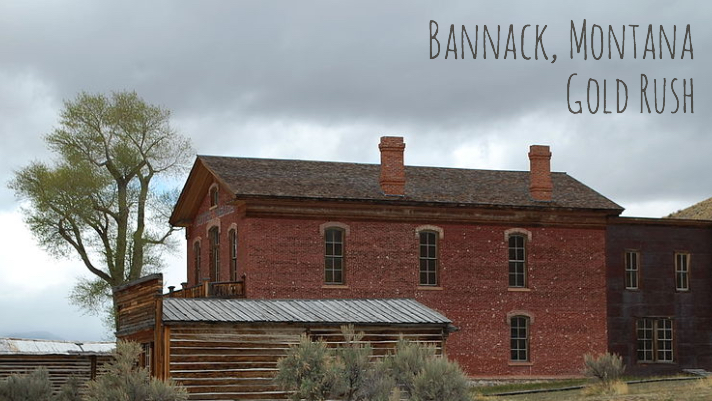
The Gold Strike on Grasshopper Creek
Bannack, Montana is just a ghost town now, but one with a very colorful history. John White, and some other miners known as the “Pikes Peakers” from Colorado, discovered gold on July 28, 1862 in Willard Creek. Lewis and Clark had named Willard Creek in 1805, but White decided Grasshopper Creek was a more fitting name for it, due to an unusually numerous population of grasshoppers in 1862.
The Pikes Peakers staked one of the earliest claims in Idaho Territory, which later became the state of Montana. As with most strikes, it didn’t take long for the news to spread, resulting in the biggest gold rush since the 1848 California Gold Rush. Almost immediately a mining camp sprang up, with tents, dugouts, huts, shanties, caves – anything that could possibly serve the purpose – used as domiciles.
Although most gold tested 95% pure, the gold from Grasshopper Creek was found to be 99-99.5% pure. That news whetted the appetites of a hoard of hopeful miners, and within three months, over 400 prospectors lived and worked in the mining camp at Bannack.
A Dangerous Place to Be…
Following the initial influx of miners, settlers were not far behind, as well as Civil War deserters, bad guys, and regular businessmen who hoped to profit from the success of the camp. It’s always been said that the guy selling shovels and picks generally made more money than the miners. Unfortunately, quite a few of the early settlers did not expect the winters in Montana to be so harsh, and they suffered for it, as they did not come fully prepared with adequate supplies.
At first, as in all mining towns, the population of Bannack was primarily men. The first female residents were the prostitutes plying their trade, but of course others followed, and by 1863, Bannock boasted a population of 3,000, including many families.
The Indians of the nearest tribe were known as the Bannock, and the town applied for that name for their town. A paperwork error was made in Washington and the town ended up being spelled “Bannack”.
Wherever you find gold, you soon find robbers wanting to take advantage of the riches without having to do the work, and Bannack was no exception. Murders were numerous, and the town needed some kind of law to bring things under control. Henry Plummer came to Bannack in January of 1863, and the town folk elected him sheriff a short time later, hoping he could civilize the town. It was not to be.
The Crooked Sheriff Only Make Matters Worse
Sheriff Plummer’s position made him uniquely placed to know when gold was going to be transported. A gang of robbers known as “The Innocents” grew to over 100 men, and the robberies continued unabated, as Sheriff Plummer could pass the details of the gold shipments to his band.
Gold was discovered in May of 1863 eighty miles east of Bannock at Alder Gulch. Naturally, as the miners headed to Bannack to resupply, news of the strike was leaked and prospectors poured into Alder Gulch, which grew quickly and eventually became Virginia City. The trip between Virginia City and Bannack was a dangerous one, and prospectors making the journey were frequently robbed by the Plummer gang, with at least a hundred people being murdered in 1863 alone!
Sheriff Plummer still enjoyed the trust of the citizenry and when he was appointed as U.S. Deputy Marshall for the eastern part of Idaho Territory in August of 1863, the robberies became even more numerous, as well as violent. However, Plummer’s days were numbered.
Also Read: The Rowdy Silver Mining Camp of Pioche, Nevada
And: Early Days in Garnet – One of Montana’s Hidden Gems
Vigilante Justice in Montana’s Lawless Gold Camps
 In September 1863, Sidney Edgerton was appointed by Abraham Lincoln to serve as Chief Justice of the Idaho Territory. But it was vigilanteism that eventually brought Plummer down. By December of that year, the citizens had no more tolerance for the holdups and the perpetual violence, and in a secret meeting, men from Virginia City, Nevada City and Bannock created the Montana Vigilantes.
In September 1863, Sidney Edgerton was appointed by Abraham Lincoln to serve as Chief Justice of the Idaho Territory. But it was vigilanteism that eventually brought Plummer down. By December of that year, the citizens had no more tolerance for the holdups and the perpetual violence, and in a secret meeting, men from Virginia City, Nevada City and Bannock created the Montana Vigilantes.
These vigilantes took to wearing masks at night, and going about to visit the homes of the men they suspected, displaying the numbers “3-7-77” at their homes. The numbers may represent the measurement for digging a grave – 3 feet by seven feet by 77 inches. It is unknown if that was the actual meaning behind the numbers, but to this day, those numbers are on the shoulder patches of the Montana State Highway Patrol.
The vigilantes did not waste time with trials, and hung 24 men, one of the men being Erastus “Red” Yager. Before he was hung, he identified the leader of the gang as being none other than Sheriff Henry Plummer. A group of 50-75 vigilantes marched Plummer and two of his cohorts – Buck Stinson and Ned Ray – to the gallows on January 10, 1864. After hanging Plummer’s two friends, they put the rope around his neck.
Legend has it that he told the mob he would divulge the location of $100,000 in gold if they would let him go. It made no difference – they strung him up anyway.
The most mysterious aspect of the story is that the robberies continued. Historians are of the opinion that the real culprits were the vigilantes themselves, and that they pinned the crimes on Plummer to cover their own guilt. But that is something we will never know.
By 1867 the vigilantes were the only law in the mining towns, but in March of 1867 the citizens had grown weary of the lynchings and of the vigilante justice, and let it be known that if they hung one more person, the town folk would hang five vigilantes. The vigilantes had had their day, but it was over now, and the area settled down at last.
Next: Miner’s are Finding Gold Nuggets in Montana… Big Ones!

